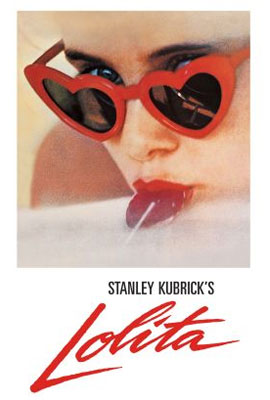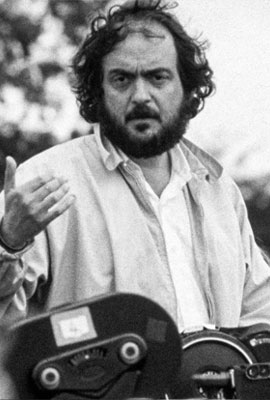
(1962)
directed by Stanley Kubrick
Vladimir Nabokov, the renowned author of the novel “Lolita,” wrote the screen play for Stanley Kubrick’s film. The film tells the story of a middle-aged professor of French literature who becomes obsessed with a teenage girl. The film stars Sue Lyon as Lolita, James Mason as Humbert Humbert, the professor, Shelley Winters as Charlotte Haze, Lolita’s mother, and Peter Sellers as Clare Quilty. The actress who plays Lolita, Sue Lyon, was fourteen at the time of filming.
The film begins with an astonishing sequence taken from the end of the novel. There is a violent confrontation between two men. Clare Quilty, drunk and incoherent, plays Chopin’s Grand Polonaise on the piano while being shot to death. The shots pass through a Gainsborough painting of a young woman. The shooter is Humbert Humbert. In an interview, Nabokov, who ultimately had mixed feelings about the film, said, “The killing of Quilty is an absolute masterpiece.” From this point on, Stanley Kubrick has our undivided attention!
The film flashes back to events four years earlier. Humbert is searching for a room to rent and Charlotte Haze, a sexually frustrated widow, has a room available. Finding Charlotte’s rather obvious romantic overtures to be annoying, Humbert declines the room. Then he sees Lolita, Charlotte’s teenage daughter. Lolita is wearing heart-shaped sunglasses. She is a soda-pop drinking, gum-snapping, flirtatious teenager. After seeing Lolita, Humbert accepts Charlotte’s offer and becomes a lodger in the Haze household.
Charlotte wants all of Humbert’s attention for herself and announces that she will be sending Lolita to an all-girl camp for the summer. While Charlotte is delivering Lolita to camp, the maid gives Humbert a letter from Charlotte confessing her love for him and demanding that he vacate at once unless he feels the same way towards her. The letter says that if Humbert is still in the house when she returns, “I will know you love me and we must get married.” Although he laughs heartily while reading Charlotte’s letter, Humbert marries Charlotte.
The household becomes very tense. Humbert becomes withdrawn and Charlotte becomes increasingly needy. When Charlotte discovers Humbert’s diary entries revealing his passion for Lolita and describing Charlotte as an “obnoxious cow,” she becomes hysterical, runs outside, and is hit by a car. She is instantly killed. Humbert drives to the summer camp to pick up Lolita, who does not know her mother is dead. They spend the night at a hotel. One of the hotel’s guests, an annoying stranger, seeks out Humbert’s company and keeps steering the conversation to his “beautiful little daughter.” During their conversation, the stranger constantly repeats that he thinks Humbert is “normal.”
The next morning, Humbert and Lolita begin a sexual relationship. The two embark on a road trip across the United States. To the outside world, they act like father and daughter. After several days, Humbert tells Lolita that her mother is dead. Humbert reports to his teaching position at Beardsley College in Ohio and enrolls Lolita in high school.
Humbert worries about Lolita’s involvement in a school play. One night he returns home to find Dr. Zempf sitting in his living room. Dr. Zempf, speaking with a thick German accent, claims to be from Lolita’s school and wants to discuss Lolita’s knowledge of “the facts of life.” He convinces Humbert to allow Lolita to participate in the school play.
While attending a performance of the play, Humbert learns that Lolita has been lying about how she has been spending her Saturday afternoons. They get into a heated argument and Humbert decides to leave Beardsley College and take Lolita on the road again. Once they are on the road, Humbert realizes that they are being followed by a mysterious car. When Lolita becomes ill, he takes her to a hospital. When Humbert returns to pick her up, she is gone. A nurse tells him she left with another man claiming to be her uncle. Humbert is devastated and has no idea how to find Lolita.
Some years later, Humbert receives a letter from a Mrs. Richard T. Schiller, which is Lolita’s married name. Lolita writes that she is married, pregnant, and in desperate need of money. Humbert goes to see Lolita and finds that she has become a rather ordinary housewife. Humbert demands that she tell him who kidnapped her three years earlier. She tells him it was Clare Quilty, the man who was following them and with whom her mother once had an affair. She adds that Quilty was the one who disguised himself as Dr. Zempf. She explains that she also had an affair with Quilty but left the relationship when Quilty demanded she begin acting in “art” films. Humbert departs to kill Quilty in his mansion.
The character Quilty transforms “Lolita” into a black comedy. His menacing mannerisms are made fascinating by Peter Sellers’ over-the-top acting. Quilty’s bizarre behavior, his awkward friendliness, and, above all, his repeated appearances suggest that Quilty personifies Humbert’s guilt stricken alter ego.
The film’s ending reveals Humbert’s deep love for Lolita. When Humbert begs Lolita to leave her husband and come away with him, she refuses. A tearful Humbert then gives Lolita all of his money. Stanley Kubrick’s “Lolita” examines the darkest of human sexual desires. Kubrick explores Humbert’s desperate love for Lolita and the profound guilt which accompanies that love.
Stanley Kubrick

Stanley Kubrick, the director of “Lolita,” is the most important film director of the twentieth century. Born in New York City to a family of Jewish immigrants from eastern Europe, Stanley Kubrick turned a childhood interest in photography into an early career in photojournalism which then evolved into a life-long obsession with film making.
His movies are stylish, daring, and technically innovative. His best known films include “Paths of Glory,” “Lolita,” “Dr. Strangelove,” “A Clockwork Orange,” “2001,” “The Shining,” and “Eyes Wide Shut.” Kubrick was able to create cultural watersheds with almost every film and in a wide variety of genres. The sheer range of his achievements is breathtaking.
Kubrick used acting, sound, music, and design to create extraordinary works of art. Such is the dazzling variety of his work, it is difficult to get a handle on him as an artist. Each film is entirely different and each film is an imagined world. Every aspect of his films was under Kubrick’s complete control.
Kubrick was modest regarding his accomplishments. He credited the film medium itself for the emotional power of his movies, “The screen is a magic medium. It has such power that it can retain interest as it conveys emotions that no other art form can hope to tackle.”
In the years since Kubrick’s death, evidence has emerged that reveals Kubrick’s rigorously detailed working methods. Kubrick’s stepdaughter Katharina, who lived with Kubrick and her mother, Kubrick’s third wife, Christiane, says that, “While Dad never threw anything away, it is unfair to call him a recluse or a hoarder. He was passionate and he loved his job. He was no more obsessive than anyone else who lives by working on something they love to do and want to get it right.”